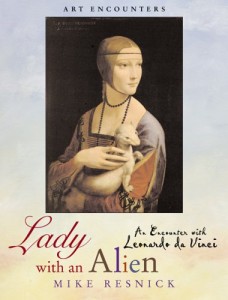 Legendary genius and the original (and literal) Renaissance man, Leonardo da Vinci, struggles with a painting commissioned by his current patron, the Regent of Milan. The problem is, the subject of the painting is an empty-headed, vacuous woman whose only virtue is her status as the Regent’s mistress, and her cat (who absolutely has to be in the painting) is uncooperative. Leonardo resents the time wasted on this project, so when a strange mystery in the form of an alien creature wanders into his life, he leaps at the chance to turn his attentions to a new topic. But the creature, which is unlike anything ever seen on Earth before, is not alone; its owner, a young man from the far future soon comes to claim it, and Leonardo convinces this boy, Mario by name, to stay for a while as his guest. Now playing host to a time-traveler and an alien, Leonardo is overjoyed, finally having intellectual challenges to fuel his curiosity. Determined to capture the look of his alien visitor for posterity, he makes some changes to his current painting-in-progress, replacing cat with alien.
Legendary genius and the original (and literal) Renaissance man, Leonardo da Vinci, struggles with a painting commissioned by his current patron, the Regent of Milan. The problem is, the subject of the painting is an empty-headed, vacuous woman whose only virtue is her status as the Regent’s mistress, and her cat (who absolutely has to be in the painting) is uncooperative. Leonardo resents the time wasted on this project, so when a strange mystery in the form of an alien creature wanders into his life, he leaps at the chance to turn his attentions to a new topic. But the creature, which is unlike anything ever seen on Earth before, is not alone; its owner, a young man from the far future soon comes to claim it, and Leonardo convinces this boy, Mario by name, to stay for a while as his guest. Now playing host to a time-traveler and an alien, Leonardo is overjoyed, finally having intellectual challenges to fuel his curiosity. Determined to capture the look of his alien visitor for posterity, he makes some changes to his current painting-in-progress, replacing cat with alien.
The days to follow are full of fascinating discussions between Leonardo and Mario, as they compare aspects of the past and future, with Mario bound to silence on a great many subjects (so as not to change history) and Leonardo forever trying to puzzle out the future (and his ultimate impact on history). The two become unlikely friends, with Mario meeting some of the greatest minds and men of Leonardo’s era, and Leonardo himself getting some idea of his place in the centuries to come. And the painting that he creates as a result of this encounter will help to cement his reputation as an artistic genius for all time.
Lady with an Alien is part of Watson-Guptill’s line of historical fiction books aimed at introducing young readers to the works and styles of various great painters. As such, the book is short (a little) on plot, and long on talking heads, exposition, and dialogue, as Leonardo and Mario exchange ideas and explore da Vinci’s world. It’s really quite well-done, educational and interesting without dragging, and it’s fun to watch Leonardo try to outsmart (and continually be stymied by) Mario in predicting the future. And of course, examining the particular genius of da Vinci has its own value. As an added bonus, there’s a brief essay on da Vinci, a timeline, and reproductions of various sketches in the back. I greatly enjoyed this book, and wouldn’t hesitate to recommend it to those interested in Leonardo da Vinci and his unique style.
Originally posted on SF Site, 2006
